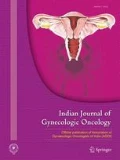Abstract
Objectives
To assess the correlation between cervical smear, colposcopic findings and loop electrosurgical excision procedure (LEEP) histopathology and thereby assess the feasibility of performing LEEP bypassing cervical biopsy in selected cases.
Methods
This is a retrospective study of patients who underwent LEEP at our institution from 2014 to 2018. We traditionally follow a three-step approach for detection and treatment of pre-invasive lesions of cervix—(1) pap smear, (2) colposcopy of abnormal pap smear cases and directed biopsy, and (3) treatment of abnormal biopsies with LEEP. LEEP was performed for cervical intraepithelial neoplasia (CIN) 2, CIN3, persistent CIN1 cases. Swede score ≥ 6 or major lesion on International Federation for Cervical Pathology and Colposcopy (IFCPC) scoring on colposcopy was considered to be suggestive of high-grade lesion.
Results
Of the 123 patients who underwent LEEP, 80 patients had high-grade squamous intraepithelial lesion (HSIL) on cervical smear and swede score ≥ 6 on colposcopy. Seventy-seven (96.3%) of these patients had high-grade lesion on final histopathology. Avoiding cervical biopsy and proceeding with LEEP in these patients would reduce an additional procedure in 77 patients with overtreatment of only 3 patients (2.4%). Overtreatment rate was 3.2% when IFCPC scoring was used instead of Swede score.
Conclusions
LEEP may be considered in patients with high-grade lesions on both colposcopy and cervical smear, bypassing cervical biopsy, thereby reducing the number of procedures performed. This reduces the financial burden for the individual and the healthcare facilities, also decreasing the anxiety and apprehension associated with multiple hospital visits and procedures.
Similar content being viewed by others
References
Schlecht NF, Platt RW, Duarte-franco E, Costa MC, Sobrinho JP, Prado JC, et al. Human papillomavirus infection and time to progression and regression of cervical intraepithelial neoplasia. J Natl Cancer Inst. 2003;95:1336.
Cox JT, Schiffman M, Solomon D. Prospective follow-up suggests similar risk of subsequent cervical intraepithelial neoplasia grade 2 or 3 among women with cervical intraepithelial neoplasia grade 1 or negative colposcopy and directed biopsy. Am J Obstet Gynecol. 2003;188:1406.
Rema P, Suchetha S, Thara S, Fayette JM, Wesley R, Sankaranarayanan R. Effectiveness and safety of loop electrosurgical excision procedure in a low-resource setting. Int J Gynaecol Obstet. 2008;103:105–10.
Prendiville W, Cullimore J, Norman S. Large loop excision of the transformation zone (LLETZ). A new method of management for women with cervical intraepithelial neoplasia. Br J Obstet Gynaecol. 1989;96(9):1054–60.
Bigrigg MA, Codling BW, Pearson P, Read MD, Swingler GR. Colposcopic diagnosis and treatment of cervical dysplasia at a single clinic visit. Experience of low-voltage diathermy loop in 1000 patients. Lancet. 1990;336(8709):229–31.
Sorbye SW, Arbyn M, Fismen S, Gutteberg TJ, Mortensen ES. HPV E6/E7 mRNA testing is more specific than cytology in post-colposcopy follow-up of women with negative cervical biopsy. PLoS ONE. 2011;6:e26022. https://doi.org/10.1371/journal.pone.0026022.
Eduardo AM, Dinh TV, Hannigan EV, Yandell RB, Schnadig VJ. Outpatient loop electrosurgical excision procedure for cervical intraepithelial neoplasia: Can it replace cold knife conization? J Reprod Med. 1996;41:729–32.
Melnikow J, Nuovo J, Willan AR, Chan BK, Howell LP. Natural history of cervical squamous intraepithelial lesions: a meta-analysis. Obstet Gynecol. 1998;92:727–35.
Guducu N, Sidar G, Bassullu N, Turkmen I, Dunder I. Three-step approach versus see-and-treat approach in patients with cytological abnormalities. Int J Clin Exp Med. 2013;6:372–6.
Singla S, Mathur S, Kriplani A, Agarwal N, Garg P, Bhatla N. Single visit approach for management of cervical intraepithelial neoplasia by visual inspection & loop electrosurgical excision procedure. Indian J Med Res. 2012;135:614–20.
Ebisch RMF, Rovers MM, Bosgraaf RP, et al. Evidence supporting see-and-treat management of cervical intraepithelial neoplasia: a systematic review and meta-analysis. BJOG. 2016;123:59–66.
Irvin WP, Andersen WA, Taylor PT, Stoler MH, Rice LW. “See-and-treat” loop electrosurgical excision. Has the time come for a reassessment? J Reprod Med. 2002;47:569–74.
Cho H, Kim JH. Treatment of the patients with abnormal cervical cytology: a “see-and-treat” versus three-step strategy. J Gynecol Oncol. 2009;20:164–8.
Aue-Aungkul A, Punyawatanasin S, Natprathan A, et al. “See and treat” approach is appropriate in women with high grade lesions on either cervical cytology or colposcopy. Asian Pac J Cancer Prev. 2011;12:1723–6.
Bosgraaf RP, Peter-Paul M, Struik-van der Zanden PHTH, Bulten J, Massuger LFAG, Bekkers RLM. Overtreatment in a see-and-treat approach to cervical intraepithelial lesions. Obstet Gynecol. 2013;121(6):1209–16. https://doi.org/10.1097/AOG.0b013e318293ab22.
Author information
Authors and Affiliations
Corresponding author
Ethics declarations
Conflict of interest
The authors declare that there are no conflicts of interest.
Additional information
Publisher's Note
Springer Nature remains neutral with regard to jurisdictional claims in published maps and institutional affiliations.
Rights and permissions
About this article
Cite this article
Vijayashanti, T., Rema, P., Suchetha, S. et al. Loop Electrosurgical Excision Procedure in a Low-Resource Setting: Feasibility of Selective See-and-Treat Approach. Indian J Gynecol Oncolog 19, 26 (2021). https://doi.org/10.1007/s40944-021-00497-w
Received:
Revised:
Accepted:
Published:
DOI: https://doi.org/10.1007/s40944-021-00497-w



